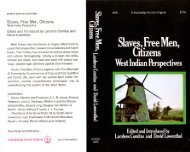e - CIFAS
e - CIFAS
e - CIFAS
You also want an ePaper? Increase the reach of your titles
YUMPU automatically turns print PDFs into web optimized ePapers that Google loves.
I<br />
Muhammadu Makau<br />
(at Zaria, 1802-4:)<br />
(at Zuba. 1804-25)<br />
3<br />
GOVERNMENT IN<br />
NINETEENTH-CENTURY ABUJA<br />
I. INTRODUCTION<br />
(a) Same Preliminaries<br />
THB government of Ahuja is complex and unfamiliar, and I<br />
therefore summarize its essentials here as an introduction to<br />
the analysis which follows.· But before plunging into this<br />
synopsis certain points must be mentioned briefly/Ol<br />
Kingship is a focal-point of the Ahuja government. Succe55ion<br />
to kingship at Abuja was based on patrilineal descent, but the king<br />
was seh:cted by certain high officials ofthe state. 3 Thekingship and<br />
~cceSS1onofHabe rulers of Abuja since Makau's flight from Zaria<br />
City are represented in the following diagram:<br />
Ishaku Jatau<br />
(Sarkin Zazzau)<br />
1782- 1802<br />
I<br />
I<br />
Abu Ja (I) Abu Kwakwa (2)<br />
1825-51 1851-77<br />
I<br />
Ibtabim (3) Mubamman Gani (4)<br />
1877-1902 1902-17<br />
I<br />
Musa Angulu (s) Suleimanu Batau (6)<br />
1917-44 1944-<br />
I ProfCllSOl" Nadel's account of Nupe llate organizlltion shows lome parallels<br />
to the8llAbuja data' d. Nadel, 1942. pp. 93-U4,.<br />
J MlIBterton-Smith, n.d. 'paras. 13-18. I have prepared D. chart oftbe office, of<br />
the Abuju guvenunent Il!llllg the data provided by Mallam Ha8san and Mr<br />
Mu~n~Smi1h•.This ~ should be consulted during the following die.:<br />
CU981Otl. Further mfonoabon on the system of sovemment La prellented in<br />
AppendttA.<br />
. • M. HusIn refflI'll to th,: traditions of former ruling Queena of Hebe Zaria in<br />
hie booklet, Malum, Ba,kin ZtlZl/au na Habe. Whether $uccenion wu then<br />
patrilineal cannot be detennined on the evidence now avai.Iable.<br />
I<br />
I<br />
I<br />
:&<br />
GOVERNMENT IN NINETEENTH-CENTURY ABUJA 3S<br />
Nota:<br />
(,). (2). (3) ~ OIdeI of au=saion.<br />
= Appointments under British Rule.<br />
From the data available we cannot determine the rules which<br />
governed eligibility for succession within the royal patrilineage at<br />
Abuja, nor the degree to which the succession patterns at Abuja<br />
followed those of Habe Zazzau. Succession at Abuja was clearly<br />
patrilineal, and a royal descent-group of lineage-type is indicated,<br />
internaUy differentiated by lines descended from successive rulers.<br />
Under the British, the Abuja succession has passed alternately be·<br />
tween two houses of the royal lineage. descended from Abu}a and<br />
Abu Kwakwa respectively. Whether this is a new development, an<br />
instance of continuity, or the fulfilment of a tendency inherent<br />
within the fonner practice of succession, it is not possible to say.<br />
The exclusion of :Makau's issue from the succession indicates that<br />
the local electors exercised great influence on the succession, and<br />
thatsuccessionitselfcould modifythestructureofthe royaldescentgroup.<br />
Whether the eJectors were able to exercise this infiuence<br />
because the royal lineage was divided by rivalry for the succession,<br />
we do not know.<br />
M. Hassan mentions a small group of royal officials, two of<br />
whom were females, the lya (mother), the Sarauniya who was the<br />
king's eldest daughter, and the Dan Galadima, the king's chosen<br />
successor. Masterton-Smith adds to these the Magajin Dangi<br />
(head of the-royal?-lineage) who was a member of the order of<br />
maliarns. M. Hassan says that the title of Iya was held by 'one of<br />
the wives of the previous chief, but not necessarily the mother of<br />
the ruling chief'. 1 He notes that despite the king's choice, 'only one<br />
Dan Galadima succeeded to the chieftainship' at Abuja. s In other<br />
words, apart from the king, most ofthe royal officials were womeD<br />
who were ineligible for succession, and the king's chosen successor<br />
was systematically set aside.<br />
The present territory of Abuja, and the area over which the<br />
Sarkin Abuja claimed suzerainty at the time of the British arrival<br />
in 1900, are shown on the accompanying map.s Certain parts of<br />
this area were administered as vassal states. According to Master-<br />
1M. Hassan, 195Z, (:il), p. 34•<br />
-Ibid., and footnote.<br />
• According to Ma!lterton-Smith (op. cit., para. ~) the Emirate was '4]9<br />
square miles in the 1'}40'II.





